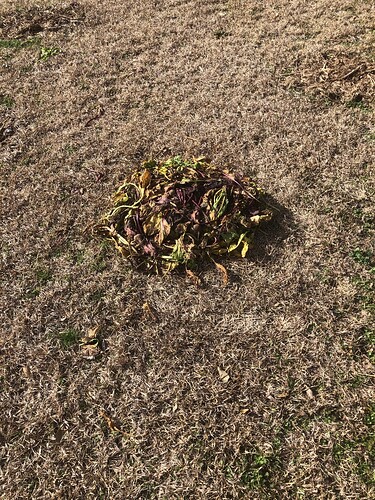Thank you for asking. I have started a few individual threads about squash projects, but they are due for a season-end update. However, I do not have a thread about my moschata project.
In brief, I planted hundreds of squash seeds, and wound up with 60-70 adult vines. Most of them stalled throughout the summer, and even though they often resumed growth around September, it was not soon enough to get fruit.
For a few reasons including a flood in 2022 that covered some traditional garden areas and personal health issues, I have focused on replacing the traditional “lawn” area around the house with vegetables and herbs. I have planted along about a quarter mile of driveway. This means that a lot of my garden areas have only been established in the last year or two. Furthermore, I’m not able to operate a tiller and I gardened by myself this year. I generally use cardboard occultizing, without wood chips, to prepare beds.
Some of my plantings look very much like I’ve seen yours: a grid of squash vines out into an area that doesn’t otherwise look like it’s been established as a garden (yet).
My C. pepo and C. argyosperma squash did the best, but performance was still less than 50 squash harvested total. The majority were patty pan summer squash, less than 20 fruit are from types I planned to save seeds from. One C. maxima candy roaster type made two mature fruit on different vines, but the fruit was relatively small.
Some thoughts that I have about my project:
- The argyrosperma and pepo varieities I grew are historically known to do well here, and in the case of the patty pan squash, I’ve grown them before here and it was not a surprise they did among the best.
- Rainfall was unusually low this year, running 10-15 inches behind 2022 which was not a banner year for rainfall either.
- I have multispecies animal pressure, I think rabbits or something else was enjoying foliage.
- My varieties, whether producing fruit or not, did very well against powdery mildew, which is a big endemic disease. They did well against insects.
- I had a lot of flowers all season, the squash I harvested had every prospect of getting naturally crossed with something else that handed disease and insects well, even if it didn’t fruit.
- A lot of the soil I’m planting into has never grown squash or vegetables before. I was initially happy because it seemed like squash plants were growing pretty well. But possibly there are some limits when rainfall isn’t good and the soil hasn’t even been turned over by a shovel in many places (it depended on how well I was doing or how fast I was going on a particular day)
Grass fights back
The last thought I want to break out on its own because it has come up before here. I do think that grass suppresses some plants including squash vines in a way that reflects some kind of biological or chemical process. I cannot demonstrate it, but I feel like the weaker and farther grass is from squash, the better it is for the squash vine.
When I establish a planting out in a grassy area, my current approach is to cover about a 3x3 foot section (1 square meter) with about two layers of cardboard, and then set some rocks on top. Depending on the season, I leave it this way for 3-6 months.
I believe that is about enough space to keep the grass from working against the squash vines, but I’m sure it’s true that larger would definitely be better. As I write this, I’m thinking: could I not at least double that space? I think it would work better if I did 




